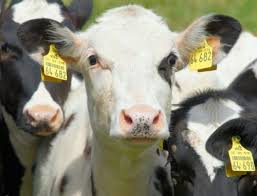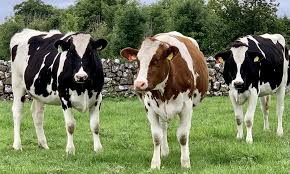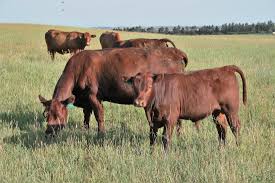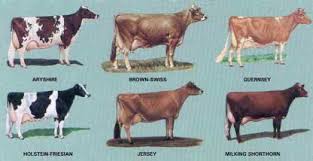Dairy breeds of cattle are specially developed for milk production, playing a crucial role in the global dairy industry. These breeds are known for their unique traits, including higher milk yield, rich nutritional content, and adaptability to various farming conditions.
Understanding the different dairy breeds is essential for farmers, dairy producers, and consumers alike, as it can influence the quality of dairy products and the economic viability of dairy farming.
Among the most popular dairy breeds, Holstein, Jersey, Guernsey, Ayrshire, and Milking Shorthorn stand out for their distinct characteristics and contributions to milk production.
Holsteins, easily recognizable by their black and white markings, are the most common dairy breed worldwide, known for their impressive milk yield and efficient feed conversion.
Jerseys, on the other hand, are smaller in size but produce milk with a higher butterfat content, making their milk highly desirable for cheese and butter production. Guernseys are celebrated for their rich golden-yellow milk, which is also high in butterfat and protein, while Ayrshires are known for their adaptability to different environments and good milk quality.
Milking Shorthorns offer a unique blend of good milk production and beef quality, making them a versatile choice for mixed farming operations.
Dairy cattle are primarily bred for their ability to produce milk, but many breeds also exhibit desirable traits for meat production. This dual-purpose aspect allows farmers to maximize their resources by utilizing cattle for both milk and beef.
Additionally, many dairy breeds have been selected over generations for traits such as disease resistance, reproductive efficiency, and temperament, contributing to their overall performance in various farming systems.
The dairy industry relies heavily on these breeds not only for their milk production but also for the economic benefits they bring to farmers and communities. Dairy farming supports millions of livelihoods worldwide and contributes significantly to food security and nutrition.
The choice of dairy breed can influence the profitability of a dairy operation, as factors such as milk yield, quality, and adaptability to local conditions can determine the success of a farm.
In recent years, advancements in genetics and technology have allowed dairy farmers to select and breed animals with superior traits, enhancing milk production and overall herd health. This focus on genetic improvement has resulted in higher-performing cattle, capable of producing more milk with less feed input.
Additionally, the introduction of artificial insemination and embryo transfer techniques has expanded the genetic pool available to dairy farmers, enabling them to select for specific traits that align with their production goals.
As the demand for dairy products continues to rise globally, understanding the various dairy breeds of cattle and their unique attributes is essential for sustainable dairy farming. Farmers must make informed decisions about which breeds to raise, taking into account factors such as climate, feed resources, market demand, and individual farm goals.
By selecting the right dairy breeds, producers can enhance their operations, improve milk quality, and contribute to the overall sustainability of the dairy industry.
Importance of Dairy Cattle in Agriculture

Dairy cattle are vital to the agricultural sector for several reasons:
1. Milk Production: Dairy cattle are primarily raised for milk, which is a staple food source. Milk provides essential nutrients, including calcium, protein, and vitamins, which are crucial for human health.
2. Economic Contribution: The dairy industry significantly contributes to the economy by generating income for farmers and creating jobs in various sectors, including processing, distribution, and retail.
3. By-Products: In addition to milk, dairy cattle produce various by-products such as cheese, yogurt, butter, and ice cream. These products are essential for diverse diets and culinary traditions.
4. Sustainable Practices: Dairy farming can promote sustainable agricultural practices. Manure from dairy cattle can be used as a natural fertilizer, enhancing soil health and reducing reliance on chemical fertilizers.
5. Livelihoods for Farmers: Many families depend on dairy farming for their livelihoods. It offers a reliable source of income, particularly in rural areas where alternative job opportunities may be limited.
Characteristics of Dairy Breeds
Dairy breeds possess specific characteristics that make them suitable for milk production. Here are some key traits to consider:
1. Milk Yield: Dairy breeds are known for their high milk production capabilities. They can produce more milk than other types of cattle.
2. Lactation Period: These breeds typically have extended lactation periods, allowing for a steady supply of milk over several months.
3. Body Size and Structure: Dairy cattle often have larger, leaner bodies compared to beef breeds. Their structure allows for efficient digestion and milk production.
4. Temperament: Many dairy breeds are known for their docile nature, making them easier to handle and care for, especially in milking operations.
5. Nutritional Requirements: Dairy cattle have specific nutritional needs to support their milk production. A balanced diet with adequate energy, protein, vitamins, and minerals is essential for optimal performance.
Popular Dairy Breeds and Their Profiles
Here are some of the most popular dairy breeds and their unique profiles:
1. Holstein: Holsteins are the most recognized dairy breed, known for their black and white markings; they are highly prolific, producing large quantities of milk, often averaging over 22,000 pounds per year, and they are generally calm and easy to manage.
2. Jersey: Jerseys are smaller in size, usually light brown in color, and are known for their high butterfat content in milk; they produce less milk than Holsteins but have a higher concentration of cream, making their milk ideal for cheese and butter production, and they are friendly and easy to handle, making them a favorite among dairy farmers.
3. Guernsey: Guernseys are medium-sized cows with reddish-brown and white patches; they are known for producing milk with a high butterfat content, contributing to rich dairy products, and they are gentle and social animals, thriving in herds.
4. Ayrshire: Ayrshires are recognized for their reddish-brown coat and white markings; they are efficient milk producers, known for their good feed-to-milk conversion ratio, and they are friendly and adaptable, making them suitable for various farming conditions.
5. Brown Swiss: Brown Swiss are large, sturdy cattle with a solid brown coat and distinctive dark nose; they are known for their high milk yield and exceptional milk quality, making them valuable in cheese production, and they are calm and resilient, adapting well to different environments.
Read Also: All You Need To Know About Dallisgrass (Paspalum Dilatatum)
Holstein: The Leading Dairy Breed

1. Characteristics: Holsteins are easily recognized by their black and white coloration. They are large, powerful animals known for their impressive size and stature.
2. Milk Production: Holsteins are the most popular dairy breed worldwide, primarily due to their exceptional milk production. A single Holstein cow can produce an average of 22,000 to 28,000 pounds of milk per year, making them the leading choice for commercial dairy operations.
3. Adaptability: Holsteins thrive in various environments, adapting well to different management systems. Their hardiness and efficiency in converting feed into milk make them a reliable choice for dairy farmers.
Jersey: The High-Butterfat Producer
1. Characteristics: Jerseys are smaller than Holsteins, with a light brown coat and a more refined appearance. They are known for their gentle temperament and ease of handling.
2. Milk Production: Jerseys are celebrated for their high butterfat content, which averages around 5% to 6%. This makes their milk particularly valuable for cheese and butter production, providing higher profitability for farmers.
3. Feed Efficiency: Jerseys are known for their excellent feed efficiency. They require less feed to produce a gallon of milk compared to larger breeds, making them an economical choice for dairy operations.
Guernsey: Rich Milk and Golden Color
1. Characteristics: Guernseys have a reddish-brown and white coat, giving them a striking appearance. They are medium-sized cattle known for their calm disposition.
2. Milk Production: Guernseys produce milk with a rich flavor and a high butterfat content, averaging around 4.5% to 5%. Their milk is prized for its quality, making it ideal for butter and cheese production.
3. Health Benefits: Guernsey milk is known for its higher levels of beta-carotene, giving it a golden color and potential health benefits. This can appeal to consumers looking for high-quality dairy products.
Ayrshire: Versatility and Efficiency
1. Characteristics: Ayrshires are medium-sized cattle, typically reddish-brown or white. They are known for their robust build and adaptability to various farming systems.
2. Milk Production: Ayrshires are known for their efficient milk production, averaging around 15,000 to 20,000 pounds of milk per year. Their versatility allows them to perform well in both grass-based and concentrate-fed systems.
3. Longevity: Ayrshires tend to have longer productive lives compared to some other dairy breeds. This longevity contributes to their overall profitability for dairy farmers, as they continue to produce milk for many years.
Milking Shorthorn: Dual-Purpose Benefits
1. Characteristics: Milking Shorthorns are known for their versatility. They have a sturdy build and can come in a range of colors, including red, white, or roan. Their calm demeanor makes them easy to handle.
2. Milk Production: This breed is valued for its dual-purpose nature, as they are bred for both milk and beef production. They typically produce moderate amounts of milk, averaging around 12,000 to 16,000 pounds annually. The milk has a good butterfat content, making it suitable for various dairy products.
3. Meat Quality: In addition to milk production, Milking Shorthorns are also raised for their beef. They are known for producing high-quality, tender meat, making them a valuable asset for farmers looking to diversify their income sources.
Read Also: List of “23” Healing Herbs in the Bible
Red Poll: Hardiness and Good Temperament

1. Characteristics: Red Polls are easily recognizable due to their solid red color and polled (hornless) nature. They are medium-sized cattle with a calm and friendly disposition.
2. Milk Production: Red Polls are another dual-purpose breed known for producing good quality milk and beef. They typically yield around 10,000 to 14,000 pounds of milk annually, with a higher butterfat content than some other breeds.
3. Adaptability: This breed is well-known for its hardiness and ability to thrive in various environments. Red Polls are efficient grazers and can convert pasture into milk and meat effectively, making them a sustainable choice for farmers.
Factors to Consider When Choosing a Dairy Breed
1. Purpose of Farming: Decide whether you want a breed primarily for milk production, meat production, or both. Dual-purpose breeds like Milking Shorthorns and Red Polls can be ideal for farmers looking to maximize their resources.
2. Climate and Environment: Consider the climate in your region and choose a breed that can thrive in those conditions. Some breeds are more adaptable to certain climates than others.
3. Milk Production Goals: Assess your milk production goals and select a breed that meets those expectations. If high milk yield is crucial, breeds like Holsteins may be more suitable.
4. Temperament and Handling: Consider the temperament of the breed. If you are new to farming or prefer a more manageable breed, opting for calm and friendly breeds like Red Polls may be beneficial.
5. Economic Factors: Evaluate the costs associated with raising different breeds, including feed, healthcare, and facilities. Consider the market demand for milk and meat from the breeds you are interested in.
6. Support and Resources: Look for breeds that have support networks or resources available, such as breeding programs or local farming communities. This can provide valuable information and assistance in your farming journey.
Do you have any questions, suggestions, or contributions? If so, please feel free to use the comment box below to share your thoughts. We also encourage you to kindly share this information with others who might benefit from it. Since we can’t reach everyone at once, we truly appreciate your help in spreading the word. Thank you so much for your support and for sharing!
Read Also: A Comprehensive Guide To Circular Economy Consulting

